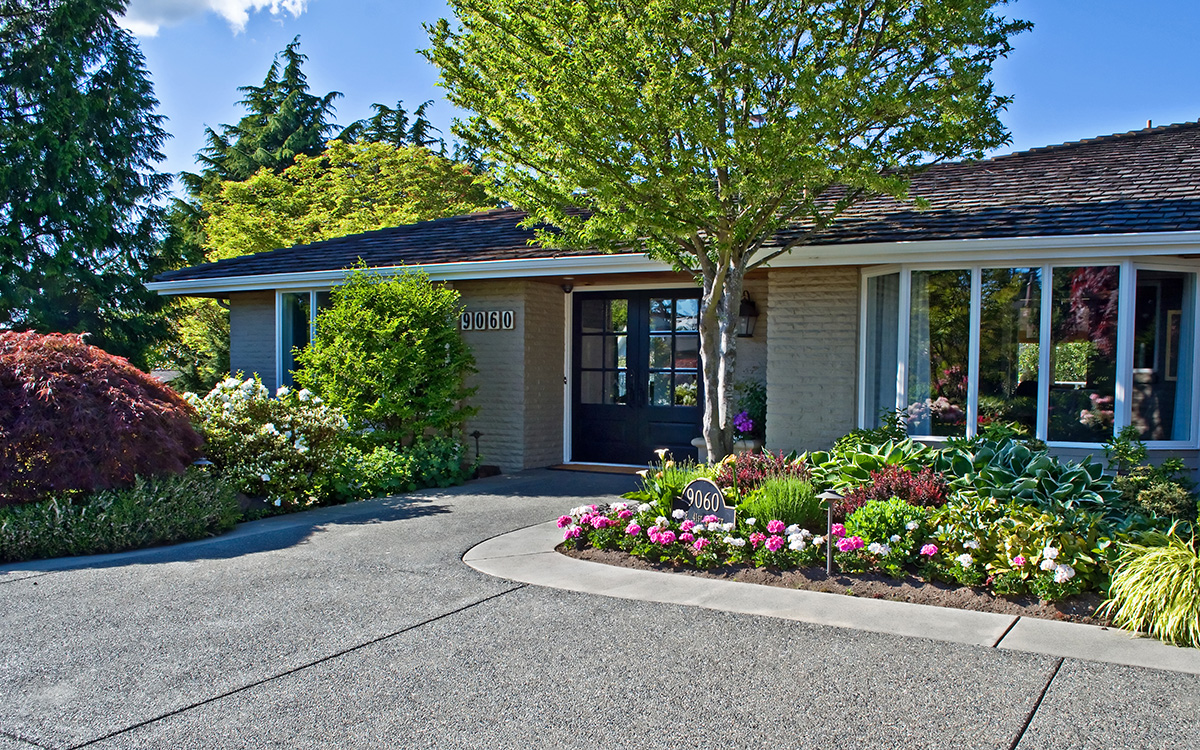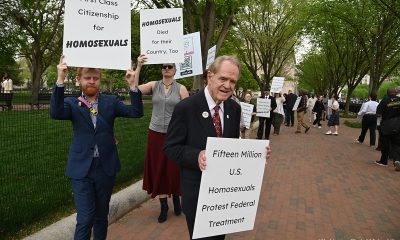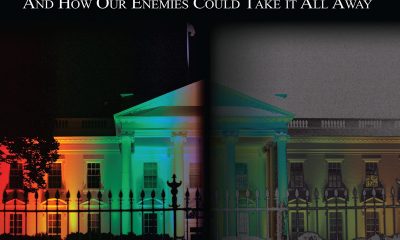Living
N.J. gay couple celebrates 51st anniversary
Vince Grimm and Will Kratz met at a downtown Reading, Pa., gay bar

VILLAS, N.J.—Vince Grimm had just left the U.S. Army Security Agency after a two-year deployment in Korea when he returned to the Reading, Pa., gay bar scene in 1961. A 20-year-old farm boy quickly caught his eye at the Big Apple Bar.
“We saw each other on and off at the bar,” said Grimm. “He was cute, blonde and kind of flamboyant — just my type.”
More than five decades later, Will Kratz pointed out with a hearty chuckle during an interview at their home that overlooks Delaware Bay a few miles north of New Jersey’s southernmost point that they consummated their relationship in the back of a 1957 Cadillac. “There was plenty of room,” added Grimm.
Kratz, who joked he was 13 when asked his age (he turns 73 later this year,) noted that Reading crime boss Abe Minker essentially allowed the gay bars to flourish because they provided a steady stream of revenue to what Grimm described as the “most corrupt city on the East Coast.” He said this pre-Stonewall scenario was a far cry from nearby Philadelphia where undercover officers regularly shook down the city’s gay bars.
“That didn’t really happen in Reading because there was income coming in from everywhere,” said Grimm. “There was a price to pay for people that had businesses and everything like that, but he kind of controlled everything. The bars were basically a safe place to go.”
“So were the streets,” added Kratz. “Nothing bad ever happened on the streets.”
The couple, who celebrated their 51st anniversary the day before the Blade interviewed them on Aug. 9, stressed that they never experienced any sort of harassment or discrimination outside of Kratz’s much older brother who never accepted his homosexuality. Their sexual orientation was never a secret to their parents and classmates. “Everybody knew us,” said Grimm, 75. “We were sexually active in school; never had any problems.”
“We had no idea we were setting a precedent”
Kratz began to perform in drag on stage in the backroom of the Zanzibar, another downtown Reading gay bar, in 1959. Grimm quickly noted that Kratz was underage at the time, but management overlooked this fact.
“They didn’t give a shit at the bar, as long as you behaved, as long as you weren’t too small to get over the bar,” added Kratz.
Kratz decided a couple of years later that he wanted to make the shows bigger. He approached the owner of the Big Apple Bar whose relatives owned a picnic grove outside Reading with buildings and a pavilion. They agreed to rent the space to him.
“Then we decided, well we’ve got to have money for these drag shows and where are we going to get it? Well let’s have barbecue chicken parties, so we had three a summer at that location,” said Kratz.

Kratz and Grimm also organized drag shows that became increasingly popular among locals (Photo courtesy of Vince Grimm and Will Kratz)
Nearly 300 people paid $5 to attend the first party that took place in 1961, but they quickly grew in popularity. Up to 1,500 revelers who came from as far away as northern New Jersey, Baltimore and even D.C. on themed buses that included those dressed as Vatican officials and the Pope attended the parties. A lesbian once arrived on an elephant with two tigers she borrowed from a local circus.
Grimm noted that they were the Reading Brewery’s largest single customer — the company delivered beer to the parties in tractor trailer trucks. Organizers also hired local firefighters, police officers and justices of the peace to work in the parking lot to thwart underage people who wanted to sneak into the gatherings.
“There was no other place for them to go, so that was like our first line of defense,” said Grimm. “Plus it made us kind of look legitimate.”
They soon, however, began to draw the attention of the Pennsylvania State Police because they created traffic jams on the local roads. Grimm noted that some of the troopers who investigated them were homophobic.
“We had some stand offs when they would come in and just kind of sit there in a car and try to intimate people,” said Grimm, who was the president of the group that organized the party. Kratz was its treasurer. “One time I think I must have stood out — stood there just staring at ‘em for like an hour, not making a move: well, when you’re ready to ask me questions I’ll be happy to answer.”
Grimm recalled one incident in which the state police claimed that underage people had attended the party. Troopers called the state Liquor Control Board that subsequently confiscated the tractor trailer that had delivered beer.
“We got on the phone with the Reading Brewery and said we have a problem,” recalled Grimm. “They said you don’t have any problem. We’re going to be there with another tractor-trailer of beer within the hour. Don’t worry about the Liquor Control Board; we’ll take care of them. Another tractor-trailer full of kegs of beer showed up within the hour.”
The only other incident that the couple said they had was a rumored police raid. The couple sought advice from another local District Justice about what to do if authorities arrested them, but she was initially confused about the entire situation.
“‘Oh my God you’re having these huge parties and all you guys are queer,’” said the judge, according to Grimm. “I said, ‘Yeah.’ She said, ‘Well … the law is the law and I’ll abide by the law. If you’ve not done anything, if everything is in place you don’t have anything to worry about.’”
Grimm then reached out to a Reading lawyer who worked for the American Civil Liberties Union to “cover my bases.” He also didn’t understand the potential problem that the couple faced.
“I tried to explain everything to him and he said the ACLU doesn’t have anything to do with a group like yours,” said Grimm. “They haven’t even gotten involved yet in gay groups. This was something totally new.”
In addition to the three parties they organized each year, Grimm and Kratz also staged drag shows that featured choreographers and up to 10 performers on stage at any given time. Judy Garland and Barbra Streisand proved popular muses, but some participants wrote entire operettas and made their costumes.
“The fire police people and the local JPs kind of found out that we were having these shows and they said, well how come you never ask us to come to these shows. We said you can come,” said Grimm. “They started to come to the Sunday matinees; they would come in suits. Their wives would come in their furs. It was totally unbelievable. This was their theater. We were their theater and they were actually the best audience that we had. We got standing ovations. They would go crazy. They couldn’t wait for us.”
A combination of Philadelphia’s burgeoning drag scene and a lack of interest among younger people prompted the couple to end their parties in 1979.
“It sounds like we were doing great things only in retrospect now because back then, we knew what we were doing, but we had no idea what we were doing,” said Kratz, who designed displays for the Strawbridge and Clothier department store at the time. “We knew our drag. We knew how to sew costume. We had no idea we were setting a precedent, for anybody. We just wanted to provide a safe place for the 1,500 or so people who ended up coming and the 500-600 who came to our shows in four weekends. We had no idea we were pre-anything else like Stonewall. We weren’t out on the streets looking for freedom. We already had it.”
Couple’s activism, generosity expands beyond Pa.
Grimm, a former engineer, joined a Bucks County group that supported people with AIDS at the beginning of the epidemic in the early 1980s that became the template for Pennsylvania’s statewide service organization for those with the virus. He also volunteered for the South Jersey AIDS Alliance and became a board member after he and Kratz retired to Cape May in 1996.
They also joined GABLES Cape May, an LGBT community and support group with more than 200 members from across the county that formed in the mid-1990s in response to homophobic commentaries about the area’s growing gay population that began to appear in the local newspaper. The organization has raised nearly $150,000 for the local Red Cross chapter and other community organizations. Both Grimm and Kratz are also on the Lower Cape May Regional High School’s advisory board.
“We know that the gays that are going to the high school over here are being harassed and are being harassed by their classmates,” said Grimm, who said this bullying does not occur at a nearby technical school where the students are more accepting of their LGBT classmates. “The kids are basically walking around hand-in-hand and nobody cares.”
The group also played a role in efforts to secure passage of both New Jersey’s domestic partnership registry and civil unions law — the couple entered into one two days after the state’s civil unions law took effect in 2007. Grimm, who is also a minister, continues to officiate these ceremonies throughout the Cape May area.
“The biggest reason for us to do it immediately was death things,” said Kratz. “When you die, the tax rate is astronomical. Now that’s going to be somewhat less. Domestic partnership is not marriage, but it’s close. We’ve heard stories and meet people that one lover died and they had to sell the house and the business to pay the tax.”
He added that he does not think that he and Grimm will live to see the day when gays and lesbians can legally tie the knot in New Jersey. Gov. Chris Christie in February vetoed a same-sex marriage bill, but Kratz stressed he expects gay weddings will eventually happen in the Garden State.
“I thought if marriage passes, am I going to have yet another dress because we had to do two ceremonies,” he joked.
When asked about the most romantic thing the couple had done for each other, Kratz immediately said travel. He and Grimm went to India and Egypt in the 1970s and have traveled around the world twice. They established the Nguyen Zian Quynh-Vince Will Education Foundation to help fatherless Vietnamese children attend school after they visited the Southeast Asian country in 2006 and befriended a guide after whom they named it.
“That’s probably one of the best, rewarding things we do,” said Grimm.
Both men stressed they remain in love with each other after 51 years.
“I’ve never had a day in my life that I wanted to kill him,” said Kratz, although he joked he came close last month after Grimm left his passport in his suitcase when they boarded a cruise ship in Copenhagen. “Never, never have I had a moment where I said I didn’t want to be here.”
Grimm added that Kratz has “backed me all of the way.”
“If I had one wish it would be that everyone could have a supporting partner like he is,” he said.
Real Estate
Boosting your rental property’s curb appeal
Affordable upgrades to attract and keep tenants happy

In the District of Columbia, the rental market tends to open up significantly during the springtime for several reasons. First, spring brings about a sense of renewal and change, prompting many individuals and families to seek new living arrangements or embark on relocations. Additionally, the warmer weather and longer daylight hours make it more conducive for people to explore housing options, attend viewings, and make decisions about moving. Furthermore, spring often coincides with the end of academic terms, leading to an influx of students and young professionals entering the rental market.
Landlords and property managers also tend to schedule lease renewals or list new vacancies during this time, capitalizing on the increased demand and ensuring a steady turnover of tenants. In the competitive world of rental properties, attracting and retaining quality tenants can be challenging. However, with some strategic upgrades, property owners can significantly enhance their units’ appeal without breaking the bank. From enhancing curb appeal to interior upgrades, here are some practical and cost-effective ideas to make your rental property stand out in the market.
Curb appeal
First impressions matter, and curb appeal plays a crucial role in attracting potential tenants. Simple enhancements like freshening up the exterior paint, adding potted plants or flowers, and ensuring a well-maintained lawn can instantly elevate the property’s appearance. Installing outdoor lighting not only adds charm but also enhances safety and security.
Interior upgrades
Upgrade the kitchen and bathroom fixtures to modern, energy-efficient options. Consider replacing outdated appliances with newer models, which not only appeal to tenants but also contribute to energy savings. Fresh paint and updated flooring can transform the look of a space without a hefty investment. Additionally, replacing worn-out carpets with hardwood or laminate flooring can make the unit more attractive and easier to maintain.
Enhance storage
Maximize storage options by installing built-in shelves, cabinets, or closet organizers. Tenants appreciate ample storage space to keep their belongings organized, contributing to a clutter-free living environment.
Improve lighting
Brighten up the interiors by adding more lighting fixtures or replacing old bulbs with energy-efficient LED lights. Well-lit spaces appear more inviting and spacious, enhancing the overall ambiance of the rental unit.
Upgrade window treatments
Replace outdated curtains or blinds with modern window treatments that allow natural light to filter in while offering privacy. Opt for neutral colors and versatile styles that appeal to a wide range of tastes.
Focus on security
Invest in security features such as deadbolts, window locks, and a reliable alarm system to ensure the safety of your tenants. Feeling secure in their home is a top priority for renters, and these upgrades can provide meaningful, genuine peace of mind.
Enhance outdoor spaces
If your rental property includes outdoor areas like a patio or balcony, consider sprucing them up with comfortable seating, outdoor rugs, and potted plants. Creating inviting outdoor spaces expands the living area and adds value to the rental property.
As landlords, investing in the enhancement of your rental properties is not merely about improving aesthetics; it’s about investing in the satisfaction and well-being of your tenants, and ultimately, in the success of your investment. By implementing these practical and affordable upgrades, you’re not only increasing the desirability of your units but also demonstrating your commitment to providing a high-quality living experience.
These efforts translate into higher tenant retention rates, reduced vacancy periods, and ultimately, a healthier bottom line. Moreover, by prioritizing the comfort, safety, and happiness of your tenants, you’re fostering a sense of community and trust that can lead to long-term relationships and positive referrals. So, let’s embark on this journey of transformation together, turning rental properties into cherished homes and landlords into valued partners in creating exceptional living spaces.
Scott Bloom is owner and Senior Property Manager of Columbia Property Management. For more information and resources, visit ColumbiaPM.com.
Real Estate
Real estate agents work hard for that commission
Despite recent headlines, buyers and sellers benefit from our expertise

With there being a lot of noise in the media lately as I am sure you have read and heard headlines like “Gone are the days of the 6% commission” and “End of the good days of Realtors,” etc., I wanted to re-run a very short article of the long laundry list of things that well versed real estate agents bring to the table to earn that seldom 6% commission. It’s typically split in half and it has always been negotiable).
As a real estate professional you will go on listing appointments and buyer meetings to not only attempt to gain business but in doing so you also educate the general public on what it is that we as real estate professionals do. I know what you’re thinking – and if you’ve seen my photo before you wouldn’t be wrong to assume that I am cast in “Selling DC” as the lead villain. I am just waiting for that phone call! But in all seriousness, when I sit down to come up with a list of things to prove to prospective clients the value in working with me as their real estate professional, I am pretty blown away at the items and qualities that a trusted professional representing you in a real estate transaction is responsible for managing a myriad of tasks, including but not limiting to the following:
• Have a pulse on the marketplace to truly understand exactly what is happening from a buying and selling standpoint while also understanding the economic side of things – not just looking at interest rates. Why are rates where they are? What employers are laying off and could cause an influx of inventory? What are the trends for individuals moving IN or OUT of an area looking like? Forecasting the marketplace of all things that truly affect real estate is vital.
• Soft Skills – these are the skills often considered as customer service skills. The ability to be approachable by all types of people and ensure that you are open to receive information. Also – when telling you bad news – it’s important to ensure that it is done in a manner in which you, the receiver, will be pleasantly receptive.
• Pre-market vendors – not only are real estate professionals expected to market your home for sale or locate a home for you to purchase, we are also expected to have a list of pre-market vendors to which you can use for your lending needs, home inspection, title work, any fluffing and buffing needed pre market for the sale of your home such as a contractor, painter, landscaper etc. We have a book of extremely well vetted vendors that either I personally have used or past clients have used that can assist with your needs. This beats Googling for hours and accidentally choosing the wrong contractor. Section A of the pre-market vendor list includes those in which we real estate professionals use for marketing materials for your property – we will use the best photographers, have floor plans drawn for your property, video, staging, catering for brokers opens and the list goes on. Again – this is a well vetted list that we have worked on for years and done all of the heavy lifting and had those uncomfortable conversations when things are not properly executed – so you don’t have to.
• On Market Tasks – these are the tasks that most clients are unaware that we do. Oftentimes when a listing is on market – folks think that I am just cruising around in my convertible buying nice things. However I am in fact going around checking each listing on market to ensure that they are clean, the booties are replaced, marketing materials are stocked, light bulbs are all working, staging looks crisp and the list truly goes on. That of course, doesn’t include the tasks we do to properly market the property such as weekly email blasts, reaching out several times to follow up with showing agents to get their feedback, check the market to see what our competition looks like, what’s under contract and why, and again…..I could go on. Needless to say the most important and time consuming tasks are those that are done when the property is on market.
• “Contract to close” management – the term contract to close is pretty much what it sounds like – it’s what happens from the time we go under contract until we reach the closing finish line and you have those keys. Once a trusted real estate professional has fiercely negotiated on your behalf as a buyer, the fun starts. Again pops up this vendor list – helping guide you though selection of a home inspector, termite inspector, etc. for the inspections. A title attorney is needed (depending on your jurisdiction) and any other vendors for quotes like renovations, etc., that you might want done to the property. Once the inspection is completed and we go through possible re-negotiations then we must ensure that the lender has the documents needed from you completed in order to have the appraisal done to prove the value of the home you are under contract for. Now we are getting into the weeds – but once we are on the other side of things and the appraisal comes back at value and the loan is clear to close then we are at the finish line to your new home.
A similar story can be told if you are selling your home. The appraisal is a very important part of the checklist as that is the value in which your home is worth. The appraiser is a third party that neither the buyer, seller, lender or myself have any allegiance to. I do, however, have the duty to educate said appraiser on why I chose the listing price and how I came up with that value.
• Post-market vendors. As mentioned before, a real estate professional should have a book of well vetted vendors from which to choose. Looking at the list of vendors now that we are on the other side of the table – I can provide a cleaning person, HVAC contractor, someone to repair the sprinkler system, a dog walker, the best caterers and bakery in town. Further down the road I am able to provide a wonderful wealth manager who can tell you what to do with that piece of real estate you purchased some time ago and we could go on for days.
While you are fully entitled to not use a real estate agent during your real estate transaction, I do believe that it is well within the realm of possibilities to say that without one there would be loose ends not completely tied up, things mismanaged and possible delays that could cost real cash. All of that aside, it is also such a truly wonderful experience to work alongside a trusted professional that at the end of the transaction becomes a new friend and family member. Real estate professionals love what they do, they love real estate and people and sheepherding you through the home buying or selling process is what it’s all about to us.
Justin Noble is a Realtor with Sotheby’s international Realty licensed in D.C., Maryland, and Delaware for your DMV and Delaware Beach needs. Specializing in first-time homebuyers, development and new construction as well as estate sales, Justin is a well-versed agent, highly regarded, and provides white glove service at every price point. Reach him at 202-503-4243, [email protected] or BurnsandNoble.com.
Real Estate
Do you need title insurance?
Facilitating smoother and more efficient real estate transactions

A title search is an examination of public records to determine the legal ownership of a property and identify any claims or liens against it. This comprehensive investigation delves into deeds, mortgages, court records, tax records, and other documents related to the property’s history. The objective is to verify that the seller has the legal right to transfer ownership of the property and that there are no undisclosed issues that could cloud the title.
I would surmise that most buyers have never read their title report or policy and I confess that I was one of them until 2005, when I bought a house in San Diego. While I was “in escrow,” my agent presented me with a title report. My first reaction was, “What do I do with this?” He replied, “review it and sign indicating that it is acceptable.” I had no idea what to look for, since I had always had title companies to rely on for interpreting the results. Thankfully, it was a clean report with no liens on it other than the mortgage the seller would be paying off at settlement.
Here, only if anything is amiss will the title attorney notify the agents and advise what the parties need to do to satisfy any conditions that could prevent them from closing. Otherwise, you won’t see the report up front.
Why are title searches important?
- They verify the seller’s legal right to transfer ownership of the property, providing assurance to the buyer that they are purchasing a legitimate asset.
- They identify any outstanding liens, mortgages, or other encumbrances that could affect the property’s value or the buyer’s ability to obtain financing.
- A title insurance policy provides coverage for losses arising from title defects such as disputes, undisclosed easements, forgery, or fraud, offering peace of mind to both buyers and lenders.
The process starts with the retrieval of documents from various sources, including county clerk offices, tax assessor’s offices, and court records.
The records are then inspected to trace the chain of ownership and identify any potential issues. The title examiner verifies the accuracy of legal descriptions, checks for inconsistencies or errors, and identifies any red flags that may indicate title defects.
If found, resolution of issues or discrepancies, such as unpaid taxes, outstanding liens, or boundary disputes must be addressed before the transaction can proceed. This may involve negotiating with creditors to satisfy outstanding debts, requesting more information from sellers, and resolving legal disputes.
Once complete, the firm will issue a title report on which to base a title policy. The buyers will receive a copy at settlement. The report provides a detailed summary of the property’s ownership history, any encumbrances or defects found during the search, and recommendations for mitigating risks.
Title insurance for the lender is required, but buyers often ask whether they need owner’s title insurance coverage too. I always recommend buying an owner’s policy. If a buyer chooses not to, then only the lender is protected from any claims revealed after the issuance of the title report. For a one-time fee, an owner’s policy protects your interest in the property and that of any heirs from future claims until the house is ultimately sold.
For example, I attended a settlement with a buyer who was purchasing a rowhouse. A woman who had power of attorney to sign for the seller was also there and, because he was overseas, the actual seller was on speaker phone to address his concerns or ask any questions.
The closing agent began reading the settlement statement aloud to indicate what was being deducted from the seller’s proceeds. The seller was fine with the amount shown for the remainder of his first mortgage, but when she read out the amount of the second mortgage, the seller, now agitated, asked, “What second mortgage?”
It then became clear that the woman, the owner’s former fiancée, had used her power of attorney to obtain a second mortgage after the title search had been done. Thanks to the title companies’ involvement, the seller was able to post a bond for the missing funds to allow settlement to proceed while he took on a legal battle with his former fiancée. Don’t try this at home, kids.
By uncovering potential issues early in the process, title searches help facilitate smoother and more efficient real estate transactions by resolving issues upfront, ensuring a seamless transfer of property ownership. But nobody knows when great Uncle Bob or your former tenant may show up with a claim to the house. You’ll need your owner’s title policy to have someone on your side.
Valerie M. Blake is a licensed Associate Broker in D.C., Maryland, and Virginia with RLAH Real Estate / @properties. Call or text her at 202-246-8602, email her via DCHomeQuest.com, or follow her on Facebook at TheRealst8ofAffairs.
-

 Africa4 days ago
Africa4 days agoCongolese lawmaker introduces anti-homosexuality bill
-

 District of Columbia1 day ago
District of Columbia1 day agoReenactment of first gay rights picket at White House draws interest of tourists
-

 World4 days ago
World4 days agoOut in the World: LGBTQ news from Europe and Asia
-

 Arizona1 day ago
Arizona1 day agoAriz. governor vetoes anti-transgender, Ten Commandments bill












